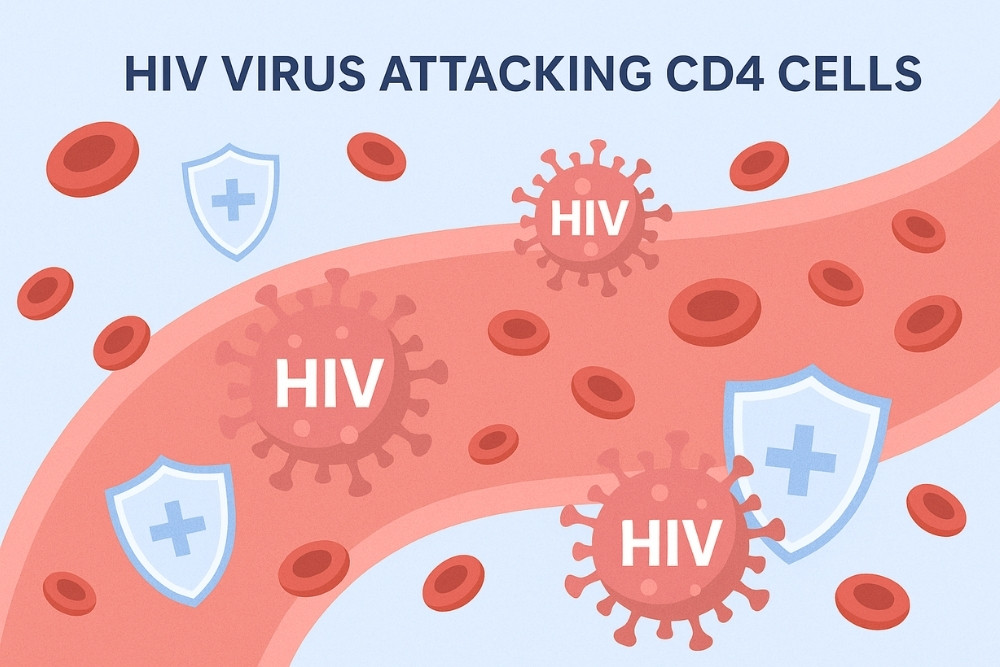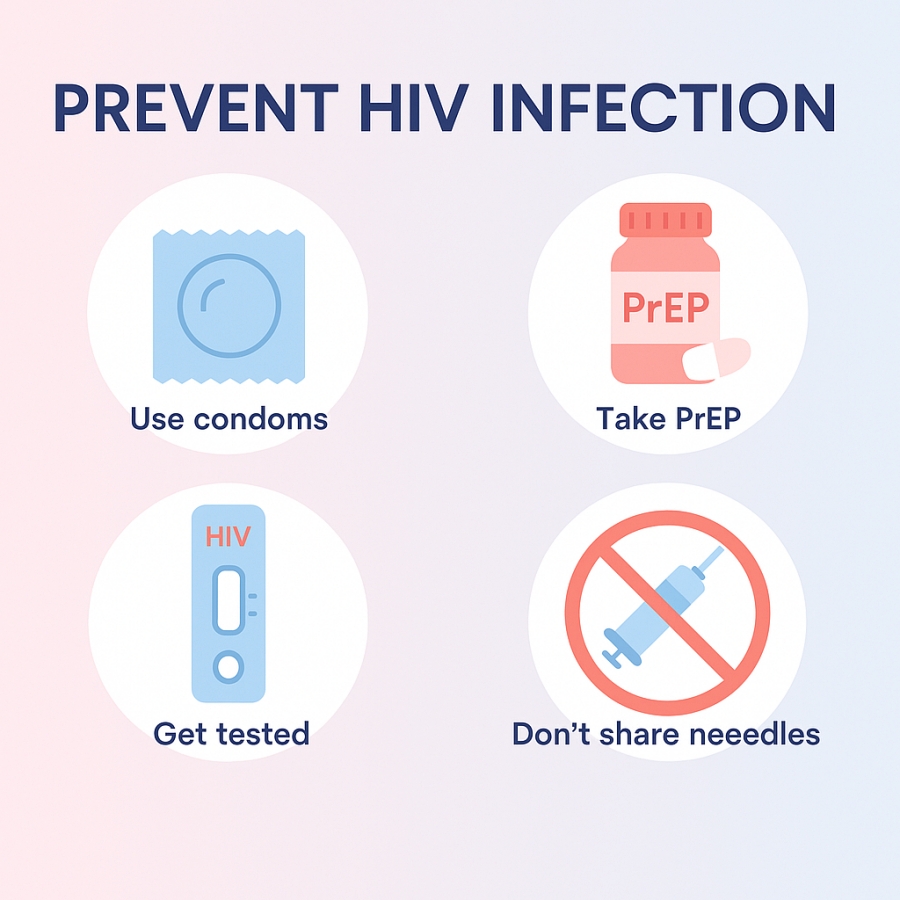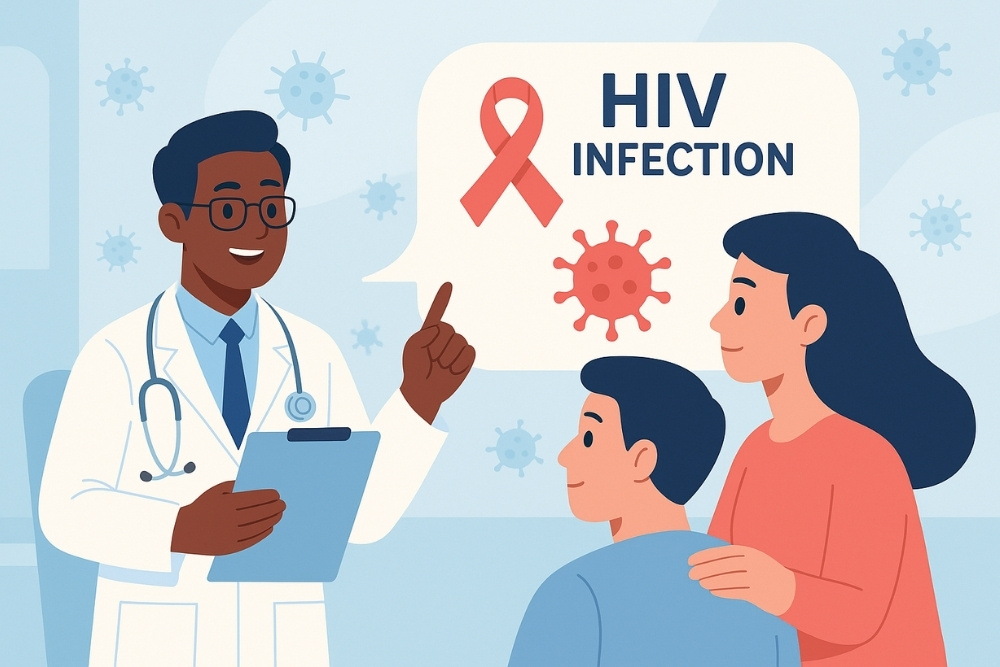HIV infection, short for Human Immunodeficiency Virus, is a virus that directly attacks the body’s immune system, weakening its ability to fight off infections and diseases. Without proper treatment, the virus can progress to a severe stage known as AIDS (Acquired Immunodeficiency Syndrome). Today, HIV remains one of the most significant global public health challenges. Although medical science has advanced greatly, understanding the virus and ensuring equal access to testing and treatment are still the keys to controlling it. With the right care and consistent treatment, people living with HIV can lead long, healthy, and fulfilling lives—no different from anyone else. This article will help you understand HIV infection from the basics — including its causes, transmission routes, symptoms, prevention methods, and the latest treatment approaches that allow individuals to live well and stay healthy.
What Is HIV Infection ?
HIV infection is caused by the Human Immunodeficiency Virus, which has a unique ability to destroy CD4 white blood cells—a crucial part of the body’s immune defense. Once inside the body, HIV gradually invades CD4 cells and uses them to produce more viruses. Over time, if untreated, the number of CD4 cells continues to drop, weakening the immune system. This makes the body unable to fight off infections or certain cancers effectively. It’s important to note that HIV infection cannot be transmitted through casual contact such as hugging, shaking hands, or sharing food. The virus spreads only through direct contact with infected bodily fluids, such as blood, semen, vaginal fluids, or breast milk.
How Does HIV Infection Spread?
There are only a few ways HIV infection can spread, and all of them can be prevented with proper awareness and action:
- Unprotected sexual contact HIV can be transmitted through vaginal, anal, or oral sex without a condom. Anal sex poses the highest risk because the lining of the anus is delicate and can easily tear.
- Sharing needles or injection equipment Using the same needles among drug users or undergoing tattoos and piercings with unsterilized tools can allow infected blood to enter the body directly.
- Mother-to-child transmission HIV infection can pass from an infected mother to her baby during pregnancy, childbirth, or breastfeeding. However, with proper treatment and medical care, the risk of transmission can be reduced to almost zero.
Importantly, HIV does not spread through kissing, hugging, using the same toilet, or eating and drinking from the same utensils. The virus cannot survive long outside the human body.
Stages of HIV Infection
HIV infection does not show immediate symptoms after exposure. It progresses through three main stages:
- Acute HIV Infection
- This stage occurs within 2–4 weeks after exposure. Some people may experience flu-like symptoms such as fever, sore throat, muscle pain, or rash. These symptoms happen as the body’s immune system responds to the virus. During this period, the amount of HIV in the blood is very high, making transmission easier.
- Chronic HIV Infection (Latent Stage)
- In this stage, the virus remains active but reproduces at very low levels. The person may not show symptoms and can feel healthy for several years. However, without treatment, HIV continues to damage the immune system gradually.
- AIDS (Acquired Immunodeficiency Syndrome)
- This is the most severe stage of HIV infection. When the immune system is heavily damaged and CD4 cell levels fall below 200 cells/mm³, the person becomes highly vulnerable to opportunistic infections such as tuberculosis, pneumonia, or certain cancers. These infections can be life-threatening if untreated.

HIV Infection vs. AIDS: What’s the Difference?
Many people confuse HIV and AIDS, but they are not the same.
- HIV (Human Immunodeficiency Virus) – The virus that attacks the immune system.
- AIDS (Acquired Immunodeficiency Syndrome) – The final stage of HIV infection when the immune system is too weak to fight off diseases.
In other words, a person with HIV infection does not necessarily have AIDS. With consistent antiretroviral therapy, people living with HIV can stay healthy and live long lives without ever developing AIDS.
Preventing HIV Infection
HIV infection can be effectively prevented through consistent, simple actions:
- Use condoms every time you have sex. Condoms are the most effective and accessible method to prevent both HIV and other sexually transmitted infections (STIs).
- Take PrEP (Pre-Exposure Prophylaxis). PrEP is medication taken before potential exposure to HIV to prevent infection. It’s highly recommended for individuals at higher risk, such as those with multiple partners or whose partners’ HIV status is unknown.
- Avoid sharing needles. Always use sterile equipment for injections, tattoos, or piercings.
- Get tested regularly. Regular HIV testing—at least once or twice a year—helps you know your status and prevents further transmission.
How Do You Know If You Have HIV Infection?
Since HIV infection often shows no symptoms in its early stages, the only reliable way to know your status is through HIV testing. In Thailand, everyone is entitled to two free HIV tests per year under the Universal Health Coverage (“Gold Card”) system. Tests are available at government hospitals and sexual health clinics nationwide.
Common HIV testing methods include:
- Rapid Test: Results in 15–30 minutes.
- ELISA or NAT tests: Laboratory methods used to confirm infection with higher accuracy.
Early testing ensures timely treatment, which helps suppress the virus and protect your immune system.
The Benefits of HIV Testing
Getting tested for HIV is not just about personal health—it’s also about social responsibility. Knowing your HIV status offers many benefits:
- Early detection allows faster treatment and better outcomes.
- Helps prevent transmission to others.
- Enables you to plan relationships and future life confidently.
- Provides access to healthcare benefits and support services.
All HIV tests are confidential, and your medical information is protected under strict privacy laws.

Preventing HIV Transmission Effectively
For those already living with HIV infection, life does not have to stop. With consistent treatment and care, the risk of transmission can be reduced to nearly zero. Taking antiretroviral therapy (ART) regularly lowers the viral load in the blood to undetectable levels. This principle is known as U=U (Undetectable = Untransmittable) — meaning that when HIV cannot be detected in your blood, it cannot be transmitted to others.
People living with HIV who maintain treatment can have safe relationships, start families, and even have HIV-free children.
Protecting Yourself and Your Partner
Knowing your HIV status is the foundation of prevention. For couples, open and honest communication helps both partners stay safe. Here are key tips:
- Always use condoms.
- Take PrEP if you are HIV-negative but at risk.
- Get regular sexual health check-ups every 3–6 months.
- Take antiretroviral medicine consistently and as prescribed.
Get Treatment Without Delay
If you find out that you have HIV infection, don’t panic—and don’t wait. Starting antiretroviral treatment (ART) early helps reduce viral load quickly, restore immune function, and prevent transmission. In Thailand, all people living with HIV can receive free lifelong antiretroviral therapy through the national health system, available at public hospitals, community clinics, and specialized HIV service centers.
Treatment for HIV Infection
Although there is currently no cure for HIV infection, antiretroviral therapy (ART) allows individuals to live long, healthy, and productive lives. ART works by reducing the amount of HIV in the blood to undetectable levels, protecting CD4 cells and preventing complications.
Key principles of HIV treatment:
- Take medication consistently and on time.
- Never stop medication without consulting your doctor.
- Attend regular check-ups to monitor your health and viral load.
Modern ART has fewer side effects than older regimens, making it easier to adhere to and improving overall quality of life.
Living with HIV Without Stigma
Beyond medical treatment, acceptance—from both oneself and society—is essential. People living with HIV can study, work, love, and live normal lives. Reducing stigma and discrimination helps ensure everyone can access healthcare and support without fear. Remember, HIV is not the end of life. It is a manageable chronic condition when treated properly.
Conclusion: HIV Is Treatable — Life Can Be Full and Healthy
HIV infection was once considered a fatal disease, but modern medicine has transformed it into a controllable condition. Early testing, prompt treatment, and consistent medication allow people living with HIV to live long, healthy lives, have families, and contribute fully to society. The most important message is simple: don’t fear testing, and don’t wait too long. The sooner you know, the better you can protect your health and the people you love.
Disclaimer: This article is for educational purposes only and does not replace professional medical advice. If you believe you have been exposed to HIV or are at risk, consult a healthcare provider or a certified sexual health clinic near you as soon as possible.
Reference:
↪︎ โรคเอดส์ (HIV/AIDS) ความรู้เรื่องอาการ ระยะ และการป้องกัน

